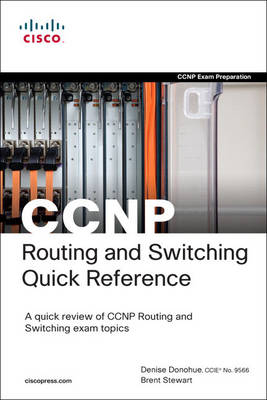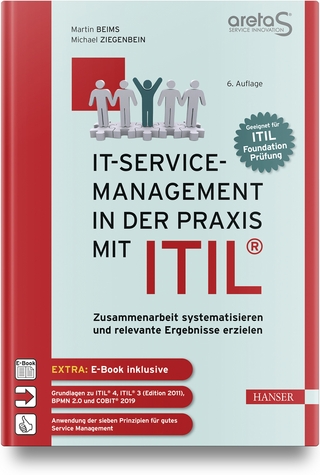
CCNP Routing and Switching Quick Reference (642-902, 642-813, 642-832)
Cisco Press (Verlag)
978-1-58720-284-1 (ISBN)
- Titel ist leider vergriffen;
keine Neuauflage - Artikel merken
Denise Donohue, CCIE No. 9566, is a senior solutions architect for ePlus Technology, a Cisco Gold partner. She works as a consulting engineer, designing networks for ePlus’ customers. Prior to this role, she was a systems engineer for the data consulting arm of SBC/AT&T. She has co-authored several Cisco Press books in the areas of route/switch and voice. Denise has worked as a Cisco instructor and course director for Global Knowledge and was a network consultant for many years. Her areas of specialization include route/switch, voice, and data center. Brent Stewart, CCNP®, CCDP®, CCSI, MCSE, is the manager of Connectivity Services at CommScope. He is responsible for designing and managing a largescale worldwide voice, video, and data network. Previously he was a course director for Global Knowledge and participated in the development of BSCI with Cisco and has written and taught extensively on CCNA® and CCNP. Brent lives in Hickory, NC, with his beautiful wife, Karen, and their mischievous children Benjamin, Kaitlyn, Madelyn, and William.
ROUTE
Chapter 1 Planning for Complex Networks 1
Network Design Models 1
Hierarchical Design Model 1
Enterprise Composite Model 2
Cisco Enterprise Architecture 7
SONA and IIN 7
Understanding Routing Protocols 9
Administrative Distance 9
Routing Protocol Characteristics 10
Building the Routing Table 11
Choosing a Route 11
Planning a Routing Implementation 12
Creating an Implementation Plan 12
Creating Implementation Documentation 13
Chapter 2 EIGRP 14
EIGRP Overview 14
EIGRP Messages 15
Packet Types 15
Neighbor Discovery and Route Exchange 15
EIGRP Route Selection 16
EIGRP Metric 16
Diffusing Update Algorithm (DUAL) 17
Route Selection Example 18
Planning an EIGRP Implementation 19
Basic EIGRP Configuration 20
Creating an EIGRP Default Route 20
Verify and Troubleshoot EIGRP 21
EIGRP Across a WAN 21
EIGRP over EoMPLS 21
EIGRP over MPLS 22
EIGRP over Frame Relay 23
WAN Bandwidth 24
Customizing the EIGRP Configuration 25
Passive Interface 25
Unicast Neighbors 25
Summarization 26
Load Balancing 26
EIGRP Authentication 27
EIGRP Scalability 29
EIGRP Stub 29
Active Process Enhancement 30
Graceful Shutdown 30
Chapter 3 OSPF 31
OSPF Overview 31
OSPF Network Structure 31
OSPF Metric 33
Link State Advertisements (LSA) 34
LSA Operation 34
LSDB Overload Protection 34
LSA Types 35
OSPF Operation 35
OSPF Packets 36
OSPF Neighbor Relationships 36
Establishing Neighbors and Exchanging Routes 37
Planning for OSPF 37
Basic OSPF Configuration 38
Router ID 39
Verify and Troubleshoot OSPF 39
OSPF Network Types 40
Designated Routers 41
Nonbroadcast Multiaccess (NBMA) Networks 42
OSPF over Layer 2 and Layer 3 MPLS 42
Advanced OSPF Configuration 42
OSPF Summarization 43
Passive Interface 43
OSPF Default Routes 44
Stub and Not-So-Stubby Areas 44
Virtual Links 45
OSPF Authentication 46
Chapter 4 Optimizing Routing 48
Controlling Routing Updates 48
Route Maps 48
Prefix Lists 52
Distribute Lists 54
Passive Interfaces 54
Using Multiple Routing Protocols 54
Configuring Route Redistribution 55
Seed Metric 55
Administrative Distance 56
Planning Route Redistribution 58
Redistribution Techniques 59
Redistribution Notes 59
Chapter 5 Path Control 61
Using Offset-lists 61
Using IOS IP SLA 62
Policy-Based Routing 64
OER and VRF 66
Chapter 6 BGP and Internet Connectivity 67
Planning an Internet Connection 67
To Route or Not to Route? 67
BGP Route Options 68
Types of ISP Connections 68
BGP Overview 69
BGP Databases 70
BGP Message Types 71
Internal and External BGP 71
BGP Next-Hop Selection 72
BGP Next Hop on a Multiaccess Network 73
BGP Synchronization Rule 73
Configuring BGP 74
BGP Network Command 74
BGP Peering 75
BGP Peering States 75
BGP Path Selection 76
BGP Attributes 76
BGP Path Selection Criteria 77
Influencing BGP Path Selection 78
Filtering BGP Routes 78
BGP Authentication 79
Verifying BGP 80
Chapter 7 Branch Office Connectivity 83
Branch Office Design Considerations 83
Small Branch Office Design 83
Medium Branch Office Design 84
Large Branch Office Design 84
Implementing Branch Offices 84
Verifying Existing Services 85
Configuring a Backup DSL Connection 85
Configuring an IPsec VPN 89
Configuring a Floating Static Route 90
Configuring Dynamic Routing over a GRE Tunnel 90
Load Sharing with EIGRP 92
Chapter 8 Mobile Worker Connectivity 93
Components of a Mobile Worker Solution 94
Implementing a Mobile Worker Solution 95
Chapter 9 IPv6 Introduction 99
IPv6 Addressing 99
Simplifying an IPv6 Address 100
Special Addresses 101
IPv6 Host Addressing 101
IPv6 Routing 104
Static Routing 105
RIPng for IPv6 105
EIGRP for IPv6 106
OSPFv3 107
MP-BGP for IPv6 109
RIPng Redistribution 109
Integrating IPv4 and IPv6 110
Tunneling IPv6 over IPv4 111
Using Address Translation 113
Static NAT-PT 113
Dynamic NAT-PT 113
IPv6 Link Types 114
Point-to-Point Links 114
Point-to-Multipoint Links 115
Multiaccess Links 115
Appendix A Understanding IPsec 117
IPsec Headers 117
Authentication Header 117
Encapsulating Security Payload 118
IPsec Modes 118
Authentication Methods 119
Encryption Methods 119
Symmetric Key Algorithms 119
Asymmetric Key Algorithm 120
Diffie-Hellman Key Exchange 120
Key Management 120
Establishing an IPsec VPN 121
Configuring a Site-to-Site VPN Using IOS 121
Configuring an ISAKMP Policy 122
Configuring an IPsec Transform Set 123
Configuring a Crypto ACL 123
Configuring a Crypto Map 124
Applying the Crypto Map to an Interface 124
Configuring an Optional Interface Access List 124
Monitoring and Troubleshooting IPsec VPNs 125
Using GRE with IPsec 125
Configuring a GRE Tunnel Using IOS 126
Appendix B IPv6 Header Format 127
SWITCH
Chapter 1 Campus Network Design 129
The Hierarchical Design Model 129
Core Layer 130
Small Campus Design 131
Medium Campus Design 131
Data Center Design 131
Network Traffic Flow 133
Service-Oriented Network Architecture 134
Planning a Network Implementation 135
Chapter 2 VLAN Implementation 137
VLAN Overview 137
VLAN Planning 139
Creating a VLAN and Assigning Ports 139
Verifying VLAN Configuration 139
VLAN Trunking 141
Configuring a Trunk Link 142
VLANs Allowed on the Trunk 143
Best Practices for Trunking 143
VLAN Trunking Protocol 143
VTP Switch Roles 144
Configuring VTP 145
Verifying and Monitoring VTP 145
Adding a New Switch to a VTP Domain 146
EtherChannels 146
Configuring an EtherChannel 147
Verifying an EtherChannel 148
Troubleshooting VLAN Issues 148
Troubleshooting User Connectivity 148
Troubleshooting Trunking 149
Troubleshooting VTP 149
Chapter 3 Spanning Tree 150
Understanding the Spanning Tree Protocol 150
Spanning Tree Election Criteria 151
STP Election 152
Bridge Protocol Data Units 154
Spanning Tree Port States 155
Per-VLAN Spanning-Tree 155
Configuring Spanning Tree 156
Portfast 156
Rapid Spanning Tree 157
RSTP Port Roles 157
BPDU Differences in RSTP 157
RSTP Fast Convergence 158
Multiple Spanning Tree 159
Spanning Tree Stability Mechanisms 159
UplinkFast 159
BackboneFast 160
BPDU Guard 160
BPDU Filtering 161
Root Guard 161
Unidirectional Link Detection 161
Loop Guard 162
Troubleshooting STP 163
Identifying a Bridging Loop 163
Spanning-Tree Best Practices 164
Chapter 4 InterVLAN Routing 166
InterVLAN Routing Using an External Router 166
InterVLAN Routing Using Multilayer Switches 167
The Layer 2 and Layer 3 Forwarding Process 167
Understanding the Switching Table 168
MLS Interfaces 168
Understanding Switch Forwarding Architectures 170
CEF Switching 170
Configuring and Troubleshooting CEF 171
Chapter 5 Implementing High Availability 173
Components of High Availability 173
Redundancy 173
Technology 173
People 174
Processes 175
Tools 175
Resiliency and High Availability 176
Network Level Resiliency 176
Fast Failover 176
Optimizing Redundancy 177
NSF with SSO 177
Designing for Redundancy 178
Layer 2 Versus Layer 3 Access Design 178
Using Nonchassis Based Access Switches 181
Network Management for High Availability 181
Syslog 182
SNMP 182
IP SLA 183
Chapter 6 First Hop Redundancy 185
Hot Standby Router Protocol 185
HSRP States 186
Configuring HSRP 186
Virtual Router Redundancy Protocol 188
GLBP 189
Planning Router Redundancy Implementation 190
Chapter 7 Campus Network Security 191
MAC Address-Based Attacks 191
MAC Address Flooding 192
Port Security 192
Port-Based Authentication 193
VLAN-Based Attacks 194
Switch Spoofing 194
802.1Q Double-Tagging 195
VACLs 195
Private VLANs 196
Protected Ports 197
Spoof Attacks 197
DHCP Spoofing 198
IP Source Guard 198
ARP Spoofing 198
Securing Your Switch 199
Chapter 8 Voice and Video in a Campus Network 200
VoIP in a Campus Network 201
Preparing the Network for VoIP 202
Voice VLANs 203
QoS for VoIP 204
Configuring VoIP Support on a Switch 206
Video over IP 208
QoS Requirements for Video 208
Chapter 9 Wireless LANs in a Campus Network 210
Cisco Unified Wireless Network 210
Characteristics of Wireless LANs 211
Service Set Identifiers (SSID) 211
WLAN Topologies 211
Client Connectivity 212
Cisco Wireless Network Components 213
Autonomous (Stand-alone) APs 213
Lightweight Access Points 214
Wireless LAN Controllers 215
Hybrid Remote Edge Access Point (H-REAP) 216
Integrating Wireless into the LAN 216
Switch Configuration 217
Planning for a Wireless Implementation 217
TSHOOT
Chapter 1 Maintenance 219
Methodology 219
Common Tasks 220
Tools 223
Configurations 223
Other Tools 228
Chapter 2 Troubleshooting Methodology 230
Principles 230
Structured Troubleshooting 231
The Troubleshooting Method 232
Integrating Troubleshooting into Maintenance 233
Chapter 3 Troubleshooting Tools 235
IOS Filtering Tools 235
Output Redirection 242
IOS Troubleshooting Tools 242
Hardware Diagnostics 246
Working with External Tools 249
Packet Sniffing 249
Netflow 250
SNMP and EEM 250
Chapter 4 Troubleshooting Switches 252
Spanning Tree 254
VLANs 257
Switched Virtual Interfaces and InterVLAN routing 258
First-Hop Redundancy 258
Chapter 5 Troubleshooting Routing 261
Network Layer Connectivity 261
Routing Protocols 261
EIGRP 262
Is the Correct Route Advertised? 262
Is the Correct Route Communicated? 263
Is There a More Desirable Path? 264
OSPF 264
Is the Correct Route Advertised? 264
Is the Correct Route Communicated? 264
Is There a More Desirable Path? 265
BGP 265
Is the Correct Route Advertised? 265
Is the Correct Route Communicated? 266
Is There a More Desirable Path? 266
Route Redistribution 267
Router Performance 268
Chapter 6 Troubleshooting Security Features 270
Troubleshooting Security Features 271
Index 273
| Erscheint lt. Verlag | 28.1.2010 |
|---|---|
| Verlagsort | Indianapolis |
| Sprache | englisch |
| Maße | 226 x 156 mm |
| Gewicht | 432 g |
| Themenwelt | Mathematik / Informatik ► Informatik ► Netzwerke |
| Informatik ► Weitere Themen ► Zertifizierung | |
| ISBN-10 | 1-58720-284-0 / 1587202840 |
| ISBN-13 | 978-1-58720-284-1 / 9781587202841 |
| Zustand | Neuware |
| Haben Sie eine Frage zum Produkt? |
aus dem Bereich


